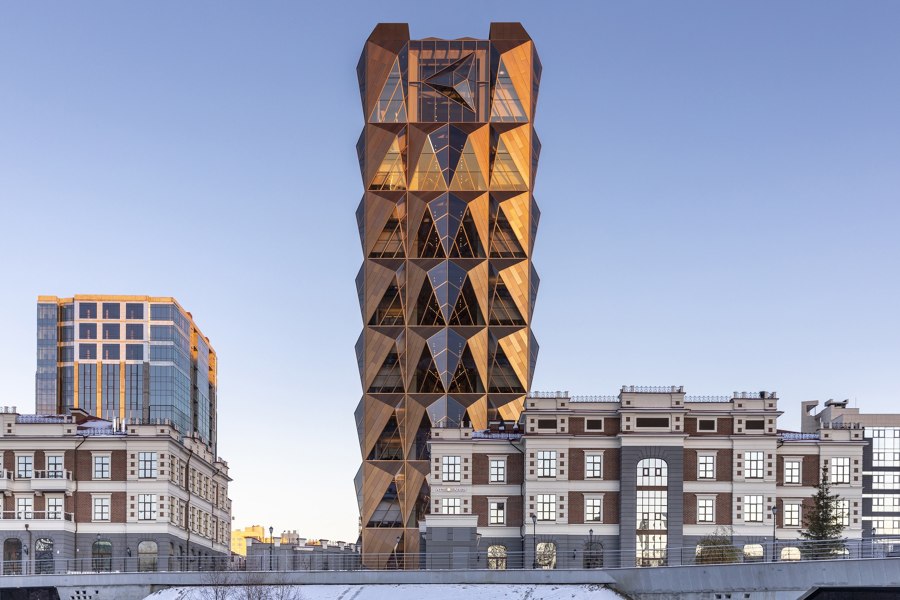RCC Headquarters in Ekaterinburg has officially opened. The practice’s first office building in Russia, the building reimagines the conventional cellular office to set new standards in quality, comfort and flexibility. The 15-storey building’s innovative modular office units are enveloped in an energy efficient enclosure, which provides a distinctive symbol for the organisation in Ekaterinburg.
RCC is one of the world’s leading producers of copper and the triangulated form draws inspiration from the chemical structure of copper. The crown of the building integrates RCC’s new logo – a rebranding which has, in turn, been inspired by the architecture.
The starting point for the office floors was to reinvent the headquarters as a ‘house for staff’ – instead of the conventional large, communal workspaces, the rooms are of a more intimate, domestic scale. The practice’s workplace consultancy group analysed the client’s operations and helped to devise the innovative modular system for these rooms. This was then developed with the in-house engineering teams to enable rapid construction and ensure ideal levels of natural daylight for concentrated work.
Each two-storey module comprises a pair of offices, stacked one on top of the other – this is expressed externally through the double-storey cladding module. The modules are arranged in rows on either side of a central hallway, which functions as a breakout space, with lounge seating and views of the city through the glazed lift shaft. At level fifteen, the space is top-lit to create a flexible space for company-wide gatherings and events.
The design targets a BREEAM Excellent rating. Responding to Ekaterinburg’s wide temperature range between seasons – often from +30°C to -30°C – the balance between solid and glazed areas is designed as a reaction to low level winter sun, while mitigating the heat of direct sunlight during the summer. The site overlooks the city and the recently landscaped river bank. Extending this greenery to the base of the building, the footprint is shifted to create a private garden for staff. The landscaping echoes the cellular internal arrangement, with a sequence of ‘external rooms’ that provide peaceful spaces for staff to relax and eat lunch. Further facilities within the building include a video conference room and boardroom, meeting spaces and an executive dining area.
Design team:
Foster + Partners
Design Team: Norman Foster, David Nelson, Spencer de Grey, Luke Fox, Angus Campbell, Jeremy Kim, Jonathan Parr, Mike Holland, Stefan Bench, Dimitri Chaava, Julija Cholopova, Louise Clausen, Amy Company Butler, Patrick Crocock, Elisa Fernandez Ramos, Charlotte Gallen, Raphael Giacomuzzo, Michelle Hudson, Martin Kehoe, Paul Kennedy, Alena Kereshun, Anton Khmelnitskiy, Annabel Knightley, Andy Lister, Sarah Lister, Yuen Nam, Connie Luk, Maria Mallalieu, Luke Moloney, Aleksejus Nevemdomskis, Charlie Parford Plant, Mariia Pashenko, Stelios Psaltis, Dina Timartseva, Harry Twigg, Vincent Westbrook, Michael Woodrow
Foster+Partners Engineers: Andrew Jackson, Andrew Coward
Other Foster+Partners Team Members: Paul Kalkhoven, Armstrong Yakubu, Sarah Villar-Furniss, George Fereday, Thouria Istephan, Matthew Burger
Collaborating Architect: P. M. VostokProekt
Traffic Engineer: MIC
Acoustic engineer: Sandy Brown
Landscape consultant: Hyland Edgar Driver
Main Contractor: A1
Structural, Mechanical And Electrical Engineer: Foster + Partners/P. M. VostokProekt
Kitchen & Logistics: Cini-Little International
Façade Engineering: Priedemann
Security System: WSP
Vertical Circulation: D2E
Lighting Design Consultants: Jason Bruges Studio





























